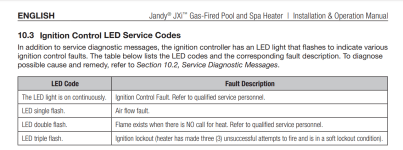Hello there! I have a Jandy JXI that was working up until a few weeks ago. I'm replacing the igniter but didn't notice anything wrong with it.
When the heater comes on, I hear the click, and like the flames are trying to come on but then it stops. Then it tries again for 2 more times and then get 3 flashing red lights. While I wait for the replacement, anything else I could check?

When the heater comes on, I hear the click, and like the flames are trying to come on but then it stops. Then it tries again for 2 more times and then get 3 flashing red lights. While I wait for the replacement, anything else I could check?








